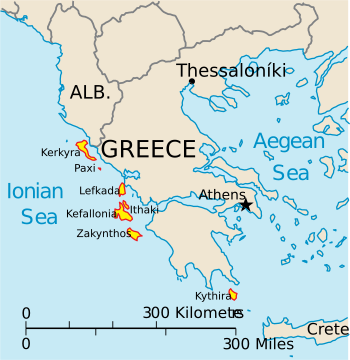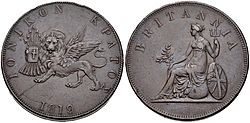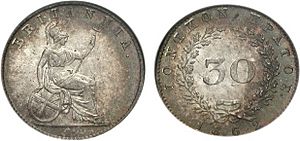United States of the Ionian Islands facts for kids
Quick facts for kids
United States of the Ionian Islands
|
|||||||||||
|---|---|---|---|---|---|---|---|---|---|---|---|
| 1815–1864 | |||||||||||
|
|
|||||||||||

The Republic's territory extended to the seven main islands plus the smaller islets of the Ionian Sea
|
|||||||||||
| Status | Amical protectorate of the United Kingdom of Great Britain and Ireland | ||||||||||
| Capital | Corfu | ||||||||||
| Official languages | Greek, English, Italian | ||||||||||
| Common languages | Venetian | ||||||||||
| Religion | Greek Orthodox | ||||||||||
| Government | Federal republic | ||||||||||
| Legislature | Parliament | ||||||||||
| Senate (executive) | |||||||||||
| Legislative Assembly | |||||||||||
| Historical era | 19th century | ||||||||||
|
• Congress of Vienna
|
9 June 1815 (signed) | ||||||||||
|
• Protectorate established
|
9 November 1815 | ||||||||||
|
• Constitution
|
26 August 1817 | ||||||||||
|
• Resolution for union with Greece
|
26 November 1850 | ||||||||||
| 29 March 1864 | |||||||||||
|
• Union with Greece
|
28 May 1864 | ||||||||||
| Area | |||||||||||
| 1864 | 4,696 km2 (1,813 sq mi) | ||||||||||
| Population | |||||||||||
|
• 1864
|
236,000 | ||||||||||
| Currency | Obol (1818–64) | ||||||||||
|
|||||||||||
| Today part of | Greece | ||||||||||
|
References: Capital city; languages.
|
|||||||||||
The United States of the Ionian Islands (Greek: Ἡνωμένον Κράτος τῶν Ἰονίων Νήσων, romanized: Inoménon-Krátos ton Ioníon Níson, lit. 'United State of the Ionian Islands'; Italian: Stati Uniti delle Isole Ionie) was a Greek state that existed from 1815 to 1864. It was a special type of protectorate under the United Kingdom of Great Britain and Ireland. This means Britain protected the islands but did not fully own them.
The Ionian Islands are a group of islands in the Ionian Sea, off the west coast of modern Greece. The capital city was Corfu. This state was formed after the Septinsular Republic and included the main Ionian Islands. It also included the town of Parga on the nearby mainland. In 1864, the British gave the islands to Greece as a gift to the new King George I. However, Parga had been sold to Ali Pasha of Ioannina in 1819.
Contents
A Brief History of the Ionian Islands
Who Ruled the Islands Before 1815?
Before the French Revolutionary Wars, the Ionian Islands were part of the Republic of Venice. In 1797, Venice was taken over, and the French took control of the islands.
From 1798 to 1799, forces from Russia and the Ottoman Empire (modern-day Turkey) drove out the French. They then set up the Septinsular Republic. This republic was mostly independent but had some control from the Ottoman Empire and Russia until 1807.
How Did Britain Take Control?
After 1807, the French took over the Ionian Islands again. But in 1809, Britain's navy defeated the French fleet near Zakynthos island. Britain then captured Kefalonia, Kythira, and Zakynthos. They also took Lefkada in 1810. The island of Corfu stayed under French control until 1814.
In 1815, after the Napoleonic Wars, a special agreement was made in Paris. This agreement, called the Treaty of Paris, gave Britain control over the Ionian Islands as a protectorate. This meant Britain would protect the islands.
The Maitland Constitution
A new set of rules, called the "Maitland constitution," was created for the islands. It was approved on August 26, 1817. This constitution created a group of seven islands working together. Sir Thomas Maitland became the first "Lord High Commissioner of the Ionian Islands". He was the main British official in charge.
During this time, many workers from Malta came to the Ionian Islands. They helped build things and worked as skilled craftspeople. They formed a community known as the Corfiot Maltese.
The Rise of Greek Nationalism
As time went on, groups who wanted the Ionian Islands to be part of Greece started to form. At first, they supported the Greek War of Independence against the Ottoman Empire. But after Greece became independent, these groups wanted the Ionian Islands to join Greece. This idea was called enosis.
The Party of Radicals was formed in 1848. This political party strongly supported enosis. In September 1848, there were small fights with British soldiers in Argostoli and Lixouri on Kefalonia. After this, some laws were relaxed, and people gained more freedom of the press. Newspapers on the islands often printed articles that criticized British policies.
On August 15, 1849, another rebellion happened. It was stopped by Henry George Ward, who temporarily put the islands under martial law.
The Push for Union with Greece
On November 26, 1850, a member of parliament named John Detoratos Typaldos suggested that the Ionian Islands should unite with Greece. Many other members signed this proposal.
Later, in 1862, the Radical party split into two groups. Even a famous British politician, William Ewart Gladstone, visited the islands. He thought the islands should join Greece, which was not what the British government wanted.
The Islands Join Greece
Finally, on March 29, 1864, representatives from Great Britain, Greece, France, and Russia signed the Treaty of London. This treaty promised to give the Ionian Islands to Greece. This was done to help the new Greek King, George I of Greece, start his rule.
So, on May 28, 1864, the Ionian Islands officially became part of Greece.
Languages Spoken in the Ionian Islands
The second constitution of the Ionian Republic, from 1803, made Greek the main official language. However, Italian was still used for official purposes, especially because of the earlier rule by the Republic of Venice.
On the island of Cephalonia, many people spoke Venetian Italian as their first language.
How the Islands Were Organized
The United States of the Ionian Islands was set up as a federation. This means it was a group of states (islands) that joined together. There were seven island states, and each had a certain number of representatives in the parliament, called the Ionian Senate.
| State | Capital City | Members Elected to Parliament |
|---|---|---|
| Corfu | Corfu | 7 |
| Cephalonia | Argostoli | 7 |
| Cythera | Kythira | 1 or 2 |
| Ithaca | Vathy | 1 or 2 |
| Paxos | Gaios | 1 or 2 |
| Leucas | Lefkada | 4 |
| Zakynthos | Zakynthos | 7 |
How the Government Worked
The British managed the government through a Lord High Commissioner. This person was chosen by the British government. Ten different men held this position over the years. One famous person was William Ewart Gladstone, who served as a special Lord High Commissioner from 1858 to 1859.
The Ionian Islands had a parliament with two parts: a Legislative Assembly and a Senate. This was called the "Parliament of the United States of the Ionian Islands."
The constitution from 1818 also created a special court for appeals. It was called the Supreme Council of Justice. The head of this court was known as the Chief Justice.
Some of the Chief Justices were:
- John Kirkpatrick (1820–1835)
- Sir James John Reid (1837–?)
- Sir Charles Sargent (1860–?)
- Sir Patrick MacChombaich de Colquhoun (1861–1864)
See also
- List of Greek countries and regions
- List of Lord High Commissioners of the Ionian Islands
- Order of St Michael and St George, a British award created because of the protectorate.





